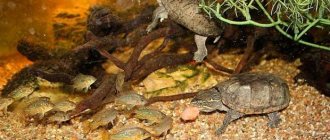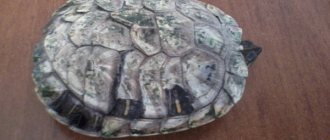Posted on Sep 2nd, 2019
by Olya
Categories:
- Dependencies
Before you get a pet, you should find out about the conditions under which it will be kept. If you want your pet to remain healthy and always in a good mood, he should be provided with proper care.
If you decide to get a land turtle , you first need to prepare the place where it will live. Please note that she should not be allowed to walk on the floor as she may get injured. The best option for keeping a turtle is an aviary. However, if you don’t have the opportunity to equip it, then a regular terrarium will do.
Terrarium size
You can make a terrarium for a land turtle with your own hands. In this case, you should first determine the size of the future product, which you will then need in order to correctly calculate the amount of materials needed.
When choosing a size, pay attention to the fact that the turtle needs space for a comfortable stay in the terrarium. Therefore, the larger the terrarium, the better.
Before designing a place to live for a reptile, it is recommended to draw a detailed plan on paper. In addition, next to the drawing you must indicate the width, length and height of the product. When choosing a suitable shape for a terrarium, give preference to rectangular or square.
Wooden model
To make a simple terrarium yourself, you don’t need much construction experience; just follow the step-by-step instructions. For wood products, the operating procedure is as follows:
- In accordance with the drawing, parts of the structure are cut out - the bottom, side and rear walls, facade.
- The surface of the bottom part and the lower part of the walls are treated with moisture-repellent impregnation.
- The side walls are attached to the bottom using ties and nails (it is better not to use metal corners, which will rust from regular wet cleaning).
- The back wall is attached to the sides and to the bottom of the terrarium - if the terrarium will be closed from above, the back wall is sometimes made of a fine, strong mesh for ventilation.
- A facade made of wood or transparent plastic is installed - if you decide to make it sliding, the top bar and guides are first attached (it is better to take plastic gutters).
- The facade is installed in the grooves, the handle is glued or screwed.
- For a closed terrarium, a lid part is made, which is attached to the top crossbar of the back wall using furniture hinges.
In a homemade device, if desired, you can build a shelf on the second floor, where the turtle will go to bask under the lamp. If your pet needs a constantly high level of humidity and temperature, you need to make a lid and drill small holes in the walls for ventilation.
Video: several options for homemade wooden terrariums
Selection of materials
A mistake many tortoise owners make is choosing a terrarium made entirely of glass. Like humans, reptiles also need peace. In a glass terrarium they will always be visible. Any careless movement, bright light and shadow fluctuations will disturb the turtle's peace. As a result, an impressionable reptile may experience constant stress, which will negatively affect its health.
The best option for a terrarium would be a combination of glass and high-quality plywood. Only the front part of the product should be made of glass. Everything else will consist of opaque plywood. You can use other materials suitable for this purpose.
Where to begin?
First of all, you need to prepare the required amount of materials for making the terrarium. To cut out blanks for your future home, you should also select the appropriate tools. For a glass and plywood terrarium, you will need a regular hacksaw and a glass hacksaw. In addition, you should definitely prepare the glue with which the structural parts will be attached.
To make a terrarium, you may also need additional materials, such as film and soil to cover the bottom of the reptile's housing. You can also use various materials for decoration: large stones, twigs or driftwood.
Terrarium from an old aquarium
An aquarium can be used as a home for a reptile, even if the seals of the seams are broken.
First, the glass must be cleaned of calcium deposits and dirt. This task can be dealt with as follows:
- moisten a rag in a 9% vinegar solution;
- wipe the container several times to dissolve the calcium;
- Once the deposits have softened, scrape them off with a glass scraper.
Repeat the procedure until the surface is completely clean. Then rinse the aquarium and let it dry.
To strengthen the seams, they are first cleaned with a knife and then degreased by wiping with a rag soaked in acetone. Next, you need to form a layer wider than the old seam, using silicone aquarium glue and a plastic spatula. You should start with the vertical walls, then move to the bottom.
At the end of the work, the aquarium should stand for twenty-four hours to allow everything to dry.
Preparing the pet's home is completed by installing lamps and covering the bottom.
For heating and lighting it is possible to use lamps on clothespins. A lamp with a reflective layer for localizing light rays and a power of 40 W is installed in one of them, the second is needed for an ultraviolet lamp with radiation of 5 Hz and a threaded socket.
The bottom is covered with reptile substrate, round pebbles, sand, hay or an artificial grass mat. Driftwood and smooth stones are used as decoration.
Stages of creating a terrarium with your own hands
It is quite possible to make a terrarium for a land turtle with your own hands without having any special knowledge. To make a home for a reptile, use the following instructions:
- We prepare all the blanks necessary for the future product, which must have smooth and neat edges.
- We fix the bottom of the future terrarium on the working surface.
- Attach the side walls using universal glue.
- We attach the back wall with glue. Be sure to check the reliability of the fastening.
- Additionally, we strengthen the structure using special corners with screws. After this, we cover the corners with special decor so that the reptile does not get injured on them.
- After all the parts of the terrarium have been assembled, we move on to attaching the front glass wall. We attach it to the plywood using the same universal glue.
- After finishing the work, we check the product for cracks. If they are found, we treat them with liquid nails or sealant. Pay attention to this stage, since if there are cracks, the turtle’s waste products may leak out. In addition, the presence of cracks can contribute to the appearance of a draft inside the terrarium, which will negatively affect the health of your pet.
Do-it-yourself islands for turtles
Aquatic turtles, despite the fact that their main habitat is water, need an island of land in their living space. If you do not provide the animal with a place where it can get out of the water and rest, the turtle will simply drown. In addition, it needs dry land to prevent certain shell diseases.
Read also: Decoction for cleansing the lungs
Video on how to make an island for turtles with your own hands
When starting to care for a turtle at home, some owners of these reptiles make islands for turtles with their own hands, while others buy everything they need at a pet store. If you decide to equip a terrarium yourself, then you should take into account that the optimal size of the land area should be such that about three turtles of the same size as yours can easily fit on it. If there are several of them in the terrarium, then the island should be made so that the animals do not feel cramped on it. In addition, it is necessary to take into account the fact that turtles often fight among themselves for territory, so it is best to equip two or more islands.
Basic requirements for islands for aquatic turtles
- Structural strength, stability and safety.
- It must be convenient for the turtle to climb onto the island, so it must be equipped with a ladder.
- Rough surface of the island and the ladder to it so that the turtle does not slip.
- Absolutely dry surface.
- Environmentally friendly materials.
- The walls of the aquarium must be at least 20 cm higher than the level of the island, otherwise the animal will escape from its home.
- The island must be heated with heating and ultraviolet lamps.
- The ladder should not be placed too close to the bottom, as the animal may get stuck between the ladder and the bottom and drown.
Made from pieces of glass with processed edges. On the surface of the glass you need to stick smooth pebbles, a special grass covering or a piece of soft polypropylene runner for the bathroom. Do-it-yourself islands for young red-eared turtles are best made “for growth,” since these penny-sized babies quickly turn into adults the size of a large man’s palm.
The island is glued to a dry and clean aquarium wall using aquarium sealant. When the turtle's housing is ready, it is necessary to leave it for several days until the glue has completely dried and weathered, and only then move the animal in.
Islands of stones
To equip the island, you can stack large stones. To make the structure strong and safe, the stones are first glued together with glue-sealant, well weathered and dried, and then placed in the aquarium.
Also, a large, stable stone is perfect for arranging an island.
Tile island
To make such an island, you need to choose tiles with a rough surface. To secure the ladder, you can drill two or three holes in it, or simply glue it with special glue.
Lid
A similar detail may be needed if you have other animals living in your house that could harm the turtle. In this case, the lid on the terrarium will protect your pet from danger.
The lid can be made from absolutely any materials. However, when choosing a suitable option, pay attention to the fact that under the cover there will be an electric lamp designed to illuminate the terrarium. Therefore, it is better for you to give preference to fire-resistant materials, such as glass or some kind of metal. When attaching the lamp, make sure that it does not touch the walls and lid of the terrarium structure.
How to properly set up a home for a land turtle
It is not enough to purchase a tank; you should also equip it based on the needs of your unusual pet.
Tank bottom
It must be covered with a thick layer of soil, otherwise the animal may wear out its claws and deform its limbs. In addition, land turtles love to dig, dig holes and burrow into the ground. Some owners place sawdust in the turtle tank, but experts do not recommend using such material.
Substances that are present in the reptile's habitat are best. You can fill the bottom of the container with coarse sand or small pebbles, and place them in different zones. Where the material is hard, the turtle will adapt to grinding its claws, and it will be happy to dive into the sand.
To facilitate the process of caring for the terrarium and eliminate the possibility of the bottom getting wet, you can place a rubberized or silicone mat under the soil material. If you use suitable soil, you can clean your turtle’s home only 2-3 times a month.
Particularly skillful owners equip their pet’s house to the highest class, equipping it with a “warm floor” system, which maintains the optimal temperature in the tank and eliminates temperature changes. The solution is excellent, but you need to take special care to protect electrical cables, since the reptile is able to dig through them.
Lighting and heating devices
Land turtles, which love warmth and need ultraviolet light, need them. To prevent the air temperature from falling below 26°C and not rising above 30°C, you can install a heater or a simple lamp whose power does not exceed 60W. An excellent imitation of the sun's rays is a lamp with a UV lamp. It is used in keeping many tropical, heat-loving pets.
Such devices should be installed no lower than 20 cm from the bottom of the tank so that the turtle does not get burned. Another suitable option is to cover the incandescent lamp with a safety grille. The duration of daylight hours for reptiles is 10-12 hours, so lighting should always be turned off at night.
There is no need to strive for the temperature to be the same throughout the turtle’s home. On the contrary, it is desirable that there be a warm and cold area where the reptile can warm up and, if necessary, cool down.
Holiday house
The reptile needs a secluded place or hole in which it can hide from others and take a break from light and bustle. The house can be made from plywood or wooden planks yourself, providing it with an open hole.
To maintain the required level of humidity in the terrarium, it is recommended to periodically spray its inner surface with water from a spray bottle; it should be a little cool. It is also advisable to equip the tank with a thermometer to determine the temperature regime.
Feeding area
The turtle needs a feeder; it is placed in a warm area of the tank and firmly secured, otherwise it will be overturned over and over again by the clumsy inhabitant. It is most convenient for these purposes to use a heavy ceramic bowl, which should be well sunk into the ground.
The dishes should not have sharp edges that could cause your pet to cut himself. The same applies to the drinking bowl. In general, special feeding devices and a water bowl for a turtle can be bought at a pet store.
Bath
Land reptiles are not averse to soaking in warm water, so if the area of the tank allows, you can install a container with low sides. It is filled with warm water, the depth of which should cover only half of the turtle’s shell. It is important that she can climb into and out of the makeshift bath on her own.
Diet of a land turtle
Representatives of this family are in most cases herbivorous reptiles. Their diet should consist of a mixture of greens and vegetables. The peculiarity is that these pets need to be given food that contains coarse fiber.
Experienced owners have gotten used to preparing salad for a turtle for several days; it can be stored well in the refrigerator for up to 3 days. But you should not give it to your reptile cold; it is advisable that it is pre-warmed to 27°-30°C.
A turtle's diet may consist of the following crops:
- carrots - roots and tops;
- zucchini;
- sweet pepper;
- eggplant;
- pumpkin pulp;
- tomatoes;
- unsweetened apples;
- berries
In the summer, you can treat your pet to dandelions, plantain, clover, and lettuce. It is recommended to grind solid food on a coarse grater, the rest can be cut into cubes. Turtles also need protein food, but it is given no more than 2 times a week. These can be legumes, mushrooms, low-fat fish.
It is important that the reptile’s diet be varied, so a plant-vegetable mixture is prepared using different ingredients. But the following food should not be on the menu of exotic pets:
- meat and dairy products (not excluding cottage cheese and cheeses);
- baked goods, including bread.
Many rodents and reptiles are fed cabbage, but it should be given to a turtle in limited quantities, since a number of substances contained in this vegetable contribute to the leaching of calcium.
The land turtle is not as emotional as most pets. But experienced owners are confident that she will be able to appreciate the care and attention with which her owner surrounds her, and will always reciprocate – in her own way, in a turtle’s way.
Ventilation
Ventilation should be provided in the terrarium, which will facilitate the flow of oxygen, sufficient air exchange and eliminate unpleasant odors arising from the turtle’s waste products. To do this, make one ventilation hole in the reptile's home. It is not recommended to do them anymore, as this may cause drafts to appear in the terrarium.
The ventilation hole should be made at the stage of creating blanks for the terrarium. Having made a hole, be sure to decorate it with a ventilation partition.
Decor
Once you have completely assembled the structure of the dwelling for the land turtle, you can move on to the final stage - designing the terrarium. It is advisable to cover the bottom with a special primer. In addition, it is necessary to provide lighting, install a bowl for feeding the pet and decorate the terrarium with decor.
As can be seen from the above, creating a terrarium with your own hands is a fairly simple and quick undertaking. The main thing in the manufacturing process is a responsible approach and careful attention to detail.
Video example of a terrarium
In this article I will talk about a terrarium for a land turtle. I’ll explain how you can make it yourself at home with your own hands. I will give examples of how to make a bottom, lighting, heating, arrangement for food and drinking bowls, islands, bridges and a house. I’ll explain what a terrarium should be like, what materials need to be used to make it.
A terrarium is a container in which living conditions for animals, insects and reptiles are created, close to natural living conditions.
What should a terrarium be like?
- Spacious. Minimum size (length and width) = pet length * 5, at least twice the height of the reptile.
- Light. Additional artificial lighting must be added.
- Warm. Be sure to include a heating system in the arrangement.
- Moisturized. There should be air spraying daily.
- With a designated place for meals.
- Located away from drafts.
At home, the best option for a turtle would be a horizontal terrarium.
Interior arrangement
In addition to the walls and bottom, the house must have lighting, heating, and a separate place for food and climbing.
Terrariums can have different designs
How and what to make the bottom from
Ideally, the bottom should be covered with a layer of soil corresponding to the pet’s natural habitat. Coarse sand and small pebbles are suitable. It is better to place a rubber mat under the bedding (for example, used for bathrooms).
It is advisable to change the soil fill once every two weeks, completely updating the contents. Or by thoroughly washing and cleaning the old one.
A good option would be to make a heated floor for your pet (for example, electric), placed under a rubber mat, so that the turtle cannot get to it and damage the wires. This system will allow you to maintain favorable temperature conditions for the reptile to live all year round.
To keep a land turtle you need soil
Lighting and heating
In their natural habitat, turtles live in a temperature range of 30 degrees C. Therefore, it is necessary to create the same temperature in the home. At the same time, in the common room there is no need to increase the air temperature at all.
Types of artificial reservoirs: pros and cons
Before arranging a home for your pet, you should decide on its size. The calculation is simple: the length of the tank should accommodate 3-6 reptile lengths - the more spacious the better. Naturally, the approximate adult size should be taken into account.
If it actively grows, the terrarium will most likely have to be replaced with a larger one or immediately provide the pet with a free home. For example, a 10-centimeter turtle needs a container at least half a meter long. As for the height and width, they must be at least 3 sizes of the individual.
If the owner wants to have 2-3 turtles, then a terrarium 2-3 times larger in volume is required. It can be made of wood, thick plastic, plexiglass or ordinary glass. But it is worth remembering that reptiles do not see transparent surfaces and can hit them. If this often happens to the turtle, you can cover the transparent area with a film, for example, with a tropical or other plant pattern.
What terrariums are most often used for a turtle house?
- An ordinary box with wooden walls . The simplest and most inexpensive option, you can buy it or make it yourself. It is advisable that one of the walls of the container is made of transparent material, for example, frosted plexiglass - this will facilitate the process of observing the reptile. It is easy to drill small holes in the wood that will provide the necessary ventilation. The bottom of the box can be lined with thin plastic or laminate. You can also use linoleum. Such an improvised terrarium must be equipped with a lid that can open upward or slide to the side.
- Plastic container . Today you can find a great variety of similar products on sale - different in color, shape and size. In addition, in the pet store you can find special plastic terrariums that are already adapted for keeping turtles. These are inexpensive tanks, but difficulties may arise when installing heating and lighting equipment. They are also encountered by owners who purchase cages or plastic carriers for their armored friends, intended for cats and rodents.
- Pen mounted on the floor . Some owners allocate part of their home to their pets and enclose the area with something like a fence. The floor is covered with linoleum and the necessary decor is installed. Such an open terrarium takes place only if the room temperature is maintained at a stable temperature and the temperature does not fall below +25°C.
- Aquarium . Although this option is more suitable for aquatic reptiles, it is also suitable for land-dwelling reptiles. It is easy to install the required devices, lid and other attributes into it. One drawback is that such a tank cannot be called cheap.
Types of home terrariums
- solid, made from one type of material, for example, plastic, glass, wood;
- combined, the camps will be created from different materials, for example, three are wooden, and one is glass, so that you can see the turtle;
- in the form of a floor pen, when the reptile moves on the floor, only the walls are made.
In the article I talked about a terrarium for a land turtle. She explained how you can make it yourself at home with your own hands. She gave examples of how to make a bottom, lighting, heating, arrangement for food and drinking bowls, islands, bridges and a house. She explained what a terrarium should be like and what materials should be used to make it.
How to set up a terrarium for land turtles
If you are wondering how to set up a terrarium for a land turtle, then you will soon become the owner of this wonderful pet. First of all, remember that reptiles, just like people, need comfort. Based on this, you can begin to arrange a terrarium, following the rules for keeping turtles in captivity.
DIY bridges for turtles
Many people have probably seen bridges for turtles in stores. These are environmentally friendly and safe products that are usually held on the walls of the aquarium using suction cups.
You can make such bridges for turtles with your own hands. The main condition for this is not to use untreated tree branches or driftwood. The fact is that pet stores sell bridges treated with a special impregnation that prevents wood from rotting. If you put an ordinary branch into an aquarium, the water in it will soon deteriorate and can even harm the health of the turtle, just like improper feeding of turtles.
DIY houses for land turtles
One turtle measuring 6 to 15 cm requires at least 0.5 m² of living space. As a terrarium for a turtle, you can use a low, long, wide and closed box with holes for ventilation.
The box can be made of wood, non-toxic impact-resistant plastic, glass or plexiglass. It should be borne in mind that these animals love privacy, so when choosing a glass house for them, only one wall should be left transparent. In addition, turtles often do not see transparent glass walls and can hit their shells against the glass, trying to pass through it.
Read also: How quickly alcohol disappears from the blood
However, most often turtles are kept in glass aquariums equipped with a shelter-house. Half of a clay flower pot, cut vertically, or half of a coconut would be perfect for such a house. You can make houses for land turtles with your own hands, or you can purchase them in specialized stores.
DIY plywood house
To work you will need:
- 4 identical plywood rectangles for the walls of the future house.
- One square piece of plywood for the roof.
- Glue for working with wood.
- Tools for woodworking.
- In two wall parts, wide arches should be cut into which the turtle will fit freely. If your animal is still small, it is recommended that when cutting out the entrance holes, make them the size of an adult animal. Otherwise, after a few months you will have to increase the size of the arches.
- Then the wall parts are connected using glue, and the roof of the house is glued on top. After treating with glue, the new home should dry and weather well.
- After about two days, you can move a new tenant into it.
Straw basket house
To arrange such a house you will need a rectangular basket, which can be purchased at any interior design store. Lay the basket on its side and make a bedding. Install heating and ultraviolet lamps above the house.
It is necessary to ensure that there is no draft in the terrarium and that the air temperature is maintained within 22˚C. Turtles are very sensitive to cold and can get pneumonia.
Have you made an island, a bridge, a house for your turtle? From what materials? Tell us about it in the comments.
How to set up a terrarium for land turtles
If you are wondering how to set up a terrarium for a land turtle, then you will soon become the owner of this wonderful pet. First of all, remember that reptiles, just like people, need comfort. Based on this, you can begin to arrange a terrarium, following the rules for keeping turtles in captivity.
Setting up a terrarium for a land turtle
Remember that a land turtle at home does not live exactly the same as in the wild. In the wild, the reptile has the opportunity to travel wherever it wants, but in your home its personal space will be limited. You should know that it is not recommended to let turtles roam around the house - the animal can simply get sick if it gets into a cold room. Also, your pet will be able to climb into a secluded place where there is a high risk that he will get stuck. In the end, you will be able to step on your pet without noticing it. Based on this, you need to understand that a terrarium for a land turtle should be spacious and not restrict the reptile’s movements. The ideal size of a home for your pet is a few square meters. Of course, everything will depend on the size of the turtle itself. Make sure your pet feels comfortable in the terrarium you choose.
The parameters of the terrarium depend primarily on the number of turtles and their size. The volume of the terrarium should be 2-6 times the size of the animal itself. If the dwelling is intended for one small turtle (6-15 cm), maintaining the boundaries of 60*50*50 will be sufficient. A terrarium for a large turtle or two small ones should not be less than 120 (100)*50*50. The formulas correspond to the following indicators: length*width*height.
Appearance of the terrarium
The terrarium looks like a wide square or rectangular box closed on all sides with a small height and special ventilation holes.
Material for making a terrarium
The materials most often used for a terrarium are non-toxic plastic, wood, plexiglass and, sometimes, ordinary glass. The transparent material is usually left for the opening side. If the turtle does not notice the glass and fights against it, it is better to apply a terrarium background.
The most convenient at home is a terrarium, the front wall of which slides apart (the glass slides out of the grooves). Or the glass can be attached with magnets. The minimum height of the side of the terrarium is 10-20 cm. This is enough so that the turtle cannot get out on its own. When choosing a height, it is also taken into account that a layer of soil will need to be poured.
Where to put a terrarium for a turtle
It is advisable to buy or make a terrarium for reptiles “for growth” with your own hands. If now you have only one small pet , then soon it will grow and take up more space. And a couple of turtles may well bring a new addition - this is worth taking into account.
When considering the location of the box with turtles, choose the coolest and most shaded rooms. In the summer heat, the sun's rays in a brightly lit room can heat a small space to 40°C, which will lead to the death of the animal.
Do not place the box in the attic or attic. Turtles will feel best in the basement, where a good waterproofing system has been thought out. If the owner lives in an apartment, then it is necessary to place the terrarium away from the windows, near a blank wall. You can fence off a living corner with a false wall or some furniture.
If you have a special love for turtles, you may have several terrariums at home - both large and small. To make all residents feel comfortable, install a special metal stand. for the shelves separating the terrariums . Cold-loving species of land turtles are usually placed on the lower tiers, and heat-loving species are placed higher up. But it’s better if you separate them and create your own living conditions for each group of reptiles.











